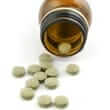Background
- Nux vomica is the dried, ripe seed of Strychnos nux-vomica L., a native tree of Burma, China, eastern India, Thailand, and northern Australia. There are reports of toxic effects with traditional use of the seeds or fruit of Strychnos nux-vomica L.
- In homeopathy, nux vomica is used for allergies, back pain, colds, constipation, digestive problems, emotional stress, flu, hangovers, headaches, hemorrhoids, and menstrual problems. Nux vomica is also a polycrest, or a homeopathic remedy used to treat many ailments. As a polycrest, nux vomica's primary indication is for disorders related to abuse of narcotic drugs, alcohol, coffee, or tobacco, overindulgence of rich food and beverages, and mental strain from excessive work.
- Athough nux vomica appeared as a treatment in 19th Century medical publications, there is very little documentation on its therapeutic effectiveness in today's standard medical journals. However, because nux vomica is a common homeopathic medicine, research continues on it, albeit in laboratory and animal studies. This remedy is in the category of unapproved herbs according to the German Commission E.
References
- Chan TY. Herbal medicine causing likely strychnine poisoning. Hum Exp Toxicol. 2002;21(8):467-468.
View Abstract - Choi YH, Sohn YM, Kim CY, et al. Analysis of strychnine from detoxified Strychnos nux-vomica [corrected] seeds using liquid chromatography-electrospray mass spectrometry. J Ethnopharmacol. 2004;93(1):109-112.
View Abstract - Deng X, Yin F, Lu X, et al. The apoptotic effect of brucine from the seed of Strychnos nux-vomica on human hepatoma cells is mediated via Bcl-2 and Ca2+ involved mitochondrial pathway. Toxicol.Sci 2006;91(1):59-69.
View Abstract - Gupta R, Manchanda RK. Reiter's disease treated with Nux vomica. Homeopathy. 2006;95(2):103-104.
View Abstract - Katz J, Prescott K, Woolf AD. Strychnine poisoning from a Cambodian traditional remedy. Am J Emerg.Med 1996;14(5):475-477.
View Abstract - Sukul A, Sarkar P, Sinhababu SP, Sukul NC. Altered solution structure of alcoholic medium of potentized Nux vomica underlies its antialcoholic effect. Br.Homeopath.J 2000;89(2):73-77.
View Abstract - Sukul A, Sinhabau SP, Sukul NC. Reduction of alcohol induced sleep time in albino mice by potentized Nux vomica prepared with 90% ethanol. Br.Homeopath.J 1999;88(2):58-61.
View Abstract - Sukul NC, De A, Dutta R, et al. Nux vomica 30 prepared with and without succession shows antialcoholic effect on toads and distinctive molecular association. Br.Homeopath.J 2001;90(2):79-85.
View Abstract - Sukul NC, De A, Sinhababu SP, Sukul A. Potentized Mercuric chloride and Nux vomica facilitate water permeability in erythrocytes of a fresh-water catfish Clarius batrachus under acute ethanol intoxication. J Altern.Complement Med 2003;9(5):719-725.
View Abstract - Sukul NC, Ghosh S, Sinhababu SP, Sukul A. Strychnos nux-vomica extract and its ultra-high dilution reduce voluntary ethanol intake in rats. J Altern Complement Med 2001;7(2):187-193.
View Abstract - Tripathi YB and Chaurasia S. Interaction of Strychnos nux-vomica-products and iron: with reference to lipid peroxidation. Phytomedicine 2000;7(6):523-528.
View Abstract - Umamaheswari M, Asokkumar K, Somasundaram A, et al. Xanthine oxidase inhibitory activity of some Indian medical plants. J Ethnopharmacol 2-12-2007;109(3):547-551.
View Abstract - Van Eenoo P, Deventer K, Roels K, Delbeke FT. Quantitative LC-MS determination of strychnine in urine after ingestion of a Strychnos nux-vomica preparation and its consequences in doping control. Forensic Sci Int 1-28-2006;
View Abstract - Yin W, Wang TS, Yin FZ, Cai BC. Analgesic and anti-inflammatory properties of brucine and brucine N-oxide extracted from seeds of Strychnos nux-vomica. J Ethnopharmacol. 2003;88(2-3):205-214.
View Abstract - Zhang X, Xu Q, Xiao H, Liang X. Iridoid glucosides from Strychnos nux-vomica. Phytochemistry 2003;64(8):1341-1344.
View Abstract







